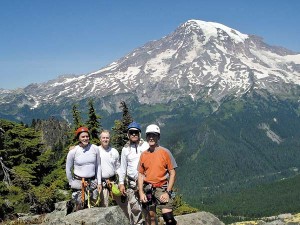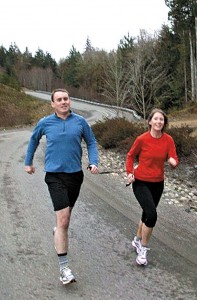Still striving
March 31, 2009 by Scott Sandsberry
Blindness doesn’t stop man from running marathons, climbing mountains ||
YAKIMA, Wash. — Some first-time runners in the Yakima River Canyon Marathon come around the bend, see the long uphill grade to the Roza cut at the 22-mile mark and groan.
Not Bruce Stobie. He won’t see it coming.

Bruce Stobie (far left) stands on the summit of Eagle Peak in 2006 alongside hiking/climbing partners Ron Fleck, John Alley and Charlie Soncrant. Stobie, blinded in an automobile accident 26 years ago, will run Saturday’s Yakima River Canyon Marathon and in July will attempt to explore that big mountain in the background, 14,411-foot Mount Rainier. (Photo courtesy of Charlie Soncrant)
That won’t bother him quite as much as not being able to see the crevasses, rock formations or steep dropoffs along the Disappointment Cleaver route on Mount Rainier when he attempts to climb the state’s highest mountain in July.
But for Stobie, simply being blind isn’t a good enough reason to stopping doing things he enjoys — though he’d dearly love to be able to see the beauty of the high country.
“It’s one thing I miss being able to see, being in the mountains and being able to see scenery,” says Stobie, a 46-year-old computer whiz living in Maple Valley. “It’s kind of hard to be there and not be able to experience that part of it, but the exercise and the challenge of it kind of make it for me.”
Stobie remembers what those mountains look like. His blindness came when he was 20, a college student at Central Washington with friends doing some off-roading in a crowded, open-top vehicle. The driver lost control above a steep embankment, and when the vehicle rolled, Stobie was ejected, slamming into the roll bar as he flew out.
The serious head trauma robbed him of sight — and ended absolutely nothing else.
All he’s done since then is develop the computer expertise that enables him to analyze and design computer systems; get married and father two children; run a marathon; and get into rock climbing and mountaineering. He does the latter much the same way he’ll run Saturday’s race — holding a strap connected to a sighted friend who serves as his eyes to keep him apprised of obstacles.
And that’s not always easy, says his sister and his running partner for Saturday’s marathon, Melissa Dunning.
“We forget he’s blind. It’s terrible when I’m running with him because I forget to tell him things. Oops, there’s a fence, stop!” laughs Dunning, who lives in Silverdale. “He gets around so well. It’s almost like a non-issue, really, the blindness. To me, he’s just a regular guy.”

Bruce Stobie and his sister, Melissa Dunning, do a training run in preparation for Saturday’s Yakima River Canyon Marathon, with each holding one end of a strap that helps guide Stobie, who is blind. (Photo courtesy of Ed Dunning)
He’s also a good enough distance runner — he’s shooting for a sub-four-hour finish Saturday — that Dunning actually prefers running with him than with her husband, Ed, who is also entered.
“I love running with my brother,” she says. “I sometimes run with my husband; he’s a little slower than me, but my husband doesn’t like to talk when we’re running, because he’s usually feeling bad and I love talking when I’m running. So I love running with my brother, because he loves to talk.
“On the long runs, we’re usually suffering at different times. That part of it is kind of hard, but it kind of helps, too — because if I was running by myself, I’d be running a lot slower. He’s a lot stronger than me.”
Stobie laughs about the thought of a lot of late-race conversation. “I notice when I’m the pain zone, the talking doesn’t really happen as much,” he says. “But I’m looking forward to meeting other people at the race, and talk with them.”
Because Stobie can’t see what’s around him, focus and concentration is critical — and not always enough. He has taken falls, twisted ankles, suffered a few bruises. “It’s just part of the overhead, basically,” he says. “I just kind of expect it.”
Stobie ran his last marathon in 1990, seven years after the accident that blinded him. He’d been a good track and cross country runner at Mount Rainier High School, so he came in hoping for a fast time — and, after starting out too fast, hit the wall. Recalls Stobie, “It was ugly.”
But it wasn’t that experience that deterred him from more marathons. A few years later, he fell into an open manhole — he was walking with a cane and missed the traffic warning cone — and injured his back. That ended his running career, at least for a while.
Over several relatively inactive years, he began to put on weight.
So three or four years ago, Stobie began working at getting back into shape — hiking, mostly, but also training on an elyptical stepper and a treadmill. Over that span, he has dropped more than 30 pounds, averages an hour of cardiovascular training every day and says training “two to three to four or five hours is not a problem.”
He’s done 20-mile runs in training, and with that one marathon under his belt — albeit nearly two decades ago — he knows what to expect. He also knows the Yakima Canyon by memory, having gotten to know it well while he was a CWU student.
His sister has done two canyon races, 2005 and 2007 — the 2005 run, in fact, was her first marathon — and the Yakima River Canyon holds a special history for her.
“My husband and I got married in Ellensburg, and we spent the first night of our marriage in Yakima — and we drove the canyon road to get there,” Melissa Dunning says. “It’s kind of cool to run it and think about how I was feeling then.”
Now, of course, she also has to think about how her brother is feeling. She doesn’t want to forget even momentarily the one thing that, because her brother’s obvious capabilities, becomes all too too easy to forget.
“Usually around 16 miles I pretty much check out, so I’m really going to have to stay alert for this one,” she says. “It’s going to be interesting.”
For Stobie, it’ll just mean four hours — less than that, hopefully — of easy terrain. A paved road is a breeze compared to some of the rutted, root-gnarled trails he has hiked. Or, worse, the boulder fields — like the one he had to traverse last year on Silver Peak, near Snoqualmie Pass.
“That was really challenging,” he recalls. “I experienced some fear and frustration. I kind of got stuck in a situation where, boy, this would be so damn easy if I could see where to put my feet.”
But he persevered and got through it — as he has done in so many ways since that accident on Manastash Ridge more than a quarter-century ago.
“One person sitting next to me died,” Stobie says. “The alternative, yeah, it’s blindness and it sucks. But considering what could have happened to me, I came out pretty OK.”
Filed under All, Featured Stories, Outdoors






